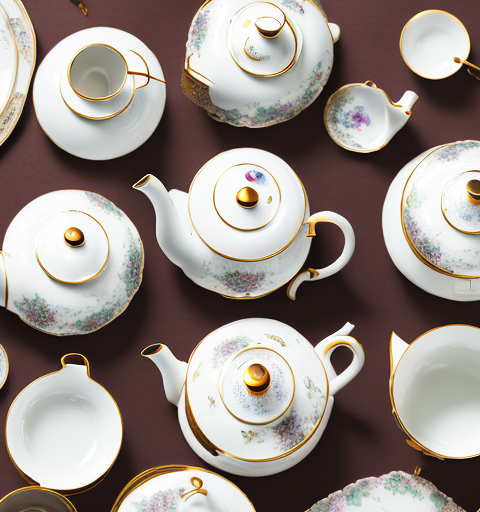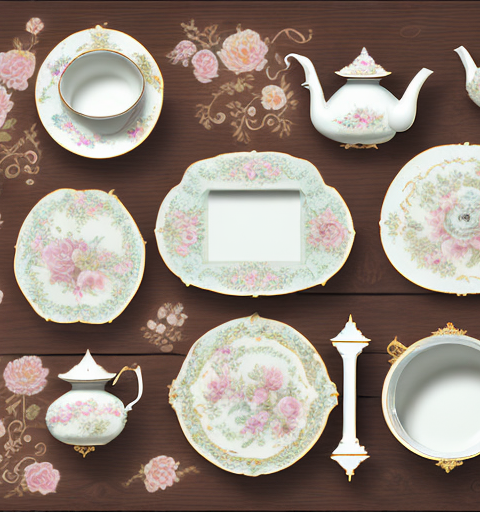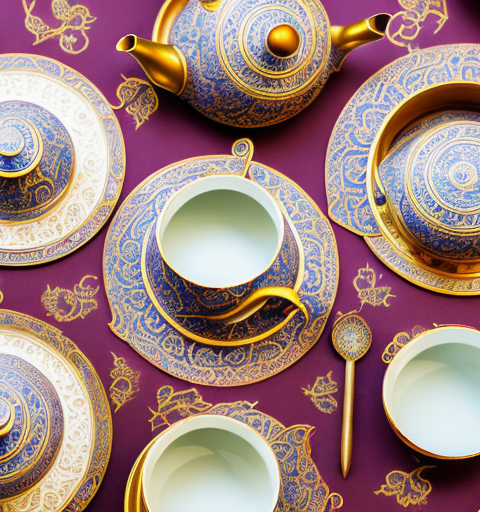Tea brewing is both an art and a science, with countless factors that can influence the final taste of your cup of tea. One such factor that often goes overlooked is the size of the ceramic teapot used for brewing. Many tea enthusiasts believe that the size of the teapot can have a significant impact on the flavor and aroma of the tea. In this article, we will delve into the science behind tea brewing and explore the relationship between teapot size and tea taste.
The Science Behind Tea Brewing: Exploring the Impact of Teapot Size
Tea is a delicate beverage that requires just the right conditions to release its full flavor potential. The size of the teapot plays a crucial role in determining the quality of the brew. In general, a larger teapot has a larger surface area, allowing the tea leaves to unfold and infuse more evenly. This can result in a more balanced and nuanced flavor profile. On the other hand, a smaller teapot may offer a more concentrated flavor, as the tea leaves are subjected to a higher leaf-to-water ratio.
Furthermore, the size of the teapot can also affect the temperature of the water during brewing. A larger teapot tends to retain heat better than a smaller one, resulting in a more consistent brewing temperature. This can have a significant impact on the extraction of flavors from the tea leaves, as different temperatures can bring out various taste notes and aromas.
Another factor to consider when it comes to teapot size is the brewing time. A larger teapot may require a longer brewing time to achieve the desired strength of the tea. This is because the larger volume of water takes longer to heat up and extract the flavors from the tea leaves. On the other hand, a smaller teapot may require a shorter brewing time, as the smaller volume of water heats up more quickly.
In addition to the brewing time, the size of the teapot can also impact the serving size. A larger teapot allows for a greater quantity of tea to be brewed at once, making it ideal for serving multiple people or for those who prefer to have multiple cups of tea in one sitting. Conversely, a smaller teapot is better suited for individuals who prefer to brew tea for themselves or for those who prefer smaller serving sizes.
Understanding the Role of Teapot Size in Tea Flavor
When it comes to tea flavor, there is a delicate balance between the various taste elements. The size of the teapot can influence this balance by altering the concentration of flavor compounds extracted from the tea leaves. In general, a larger teapot will allow for a more diluted brew, resulting in a milder taste. Conversely, a smaller teapot can lead to a more concentrated tea with a stronger flavor profile.
It’s important to note that different tea varieties may react differently to teapot size. For example, delicate green teas may benefit from a smaller teapot, as it allows for a more controlled brewing process. On the other hand, robust black teas may require a larger teapot to fully extract their rich and bold flavors.
Additionally, the material of the teapot can also impact the flavor of the tea. Porcelain and ceramic teapots are known for their ability to retain heat and distribute it evenly, resulting in a more balanced and consistent brew. On the other hand, clay teapots, such as Yixing teapots, are highly porous and can absorb some of the tea’s flavors over time, enhancing the taste with each use.
Does Size Matter? Unveiling the Relationship Between Teapot Size and Tea Taste
Size does indeed matter when it comes to the taste of tea. The relationship between teapot size and tea flavor is a complex interplay of various factors. While a larger teapot may result in a more diluted brew, it can also provide a smoother and more well-rounded taste experience. On the contrary, a smaller teapot may offer a more intense and concentrated flavor, allowing for a more robust tea experience.
It’s worth noting that personal preference plays a crucial role in choosing the right teapot size. Some individuals may prefer a lighter and more delicate brew, while others may seek a strong and bold flavor profile. Ultimately, finding the right teapot size for your desired tea taste is a matter of experimentation and exploration.
Another factor to consider when it comes to teapot size is the brewing time. A larger teapot may require a longer brewing time to extract the desired flavors from the tea leaves. This extended brewing time can result in a more nuanced and complex taste profile. On the other hand, a smaller teapot may require a shorter brewing time, which can lead to a bolder and more immediate flavor experience.
In addition to teapot size, the material of the teapot can also influence the taste of the tea. Different materials, such as ceramic, glass, or clay, can impart their own unique characteristics to the brew. For example, a clay teapot may enhance the natural flavors of the tea, while a glass teapot allows for a visually appealing experience as the tea leaves unfurl and dance in the water. Considering both the size and material of the teapot can help you create the perfect tea-drinking experience tailored to your preferences.
Exploring the Influence of Ceramic Teapot Size on Tea Flavor Profiles
Ceramic teapots, in particular, have long been favored by tea connoisseurs for their ability to enhance the flavor of tea. The material of the teapot can interact with the tea leaves, altering the taste and aroma in subtle ways. When it comes to teapot size, ceramic teapots offer a unique set of advantages.
A larger ceramic teapot can provide a more gradual and even heat distribution during brewing, resulting in a balanced extraction of flavors. The ceramic material retains heat well, creating a stable environment for tea steeping. This can result in a more harmonious flavor profile, with each note being represented in the final cup. Additionally, the porous nature of ceramic allows for a gentle infusion, ensuring that the tea leaves release their flavors slowly and evenly.
Smaller ceramic teapots, on the other hand, can create a more intense brewing environment. The smaller surface area enables more focused heat, allowing for a more concentrated and robust brew. The result is a tea with heightened flavors and a deeper complexity.
Choosing the Right Ceramic Teapot: How Size Impacts Your Tea Experience
When selecting a ceramic teapot, it’s essential to consider the impact of size on your tea experience. As mentioned earlier, different tea varieties may require different teapot sizes to bring out their best qualities. Furthermore, your own preferences and brewing style should also be taken into account.
If you prefer a more delicate and nuanced tea, a smaller ceramic teapot may be the ideal choice. The concentrated brew that it produces can highlight the subtle flavors and delicate aromas of green or white teas. On the other hand, if you enjoy a stronger and bolder tea, a larger ceramic teapot may be more suitable. This can provide a smoother and more mellow brew for black or oolong teas.
Small vs. Large: Comparing the Taste Differences in Tea Brewed with Different-sized Ceramic Teapots
One way to truly understand the impact of teapot size on tea taste is to conduct a taste test. By brewing the same tea in both a small and a large ceramic teapot, you can compare the nuances and differences in flavor.
In a small ceramic teapot, the tea leaves may be more tightly packed, resulting in a more concentrated brew. This can lead to a stronger and more full-bodied flavor, with a pronounced aroma. On the other hand, a large ceramic teapot may produce a more balanced and well-rounded cup of tea. The tea leaves have more room to expand, allowing for a more even extraction of flavors.
During the taste test, pay attention to the various taste elements, such as sweetness, bitterness, and astringency. Note any differences in aroma and aftertaste as well. This experiment can help you better understand how teapot size influences the overall tea experience.
Unlocking the Secrets of Tea Taste: Investigating the Effect of Teapot Size on Flavor Extraction
The flavor extraction process in tea brewing is intricate and multi-faceted. When it comes to teapot size, its impact on flavor extraction is two-fold.
Firstly, the size of the teapot affects the degree of interaction between the tea leaves and the brewing water. A larger teapot provides more room for the tea leaves to unfold, releasing their flavors more easily. This can result in a more complete extraction of taste compounds from the leaves, yielding a more pronounced tea taste.
Secondly, the size of the teapot affects the brewing time. A larger teapot may require a longer brewing time to achieve optimal flavor infusion. This can allow for a more thorough extraction of flavors, resulting in a more robust and flavorful cup of tea. Conversely, a smaller teapot may necessitate a shorter brewing time to avoid over-extraction and bitterness.
Enhancing Your Tea Journey: How Ceramic Teapot Size Can Transform Your Brewing Experience
Choosing the right ceramic teapot size can have a transformative effect on your overall tea brewing experience. It allows you to tailor the taste and aroma of your tea to your preferences, creating a more personalized and enjoyable tea journey.
Experimenting with different teapot sizes can unveil new dimensions of your favorite tea varieties. It can bring out hidden flavor notes, enhance the complexity, or even introduce a new balance of taste elements. By exploring the impact of teapot size, you can discover exciting new possibilities in your tea brewing adventures.
The Art and Science of Brewing: Unraveling the Connection Between Teapot Size and Tea Flavor
Tea brewing is an exquisite blend of art and science. The size of the ceramic teapot is just one piece of the intricate puzzle that shapes the final flavor of your cup of tea. Understanding the connection between teapot size and tea flavor allows you to fully unlock the potential of your tea leaves.
By appreciating the impact of teapot size on taste and aroma, you can fine-tune your brewing process to achieve the perfect tea experience. Whether you prefer a delicate and nuanced brew or a bold and robust cup of tea, choosing the right teapot size can elevate your tea brewing to new heights.
From Sip to Sip: Analyzing the Impact of Ceramic Teapot Size on Tea Aroma and Taste
Tea is a sensory experience that engages both the taste buds and the sense of smell. The aroma of the tea is closely intertwined with its taste, and the size of the ceramic teapot can influence both elements.
A larger ceramic teapot allows for more space for the tea leaves to release their aroma molecules. As the hot water comes into contact with the leaves, the aroma compounds are released and carried by the steam. This diffusion of aroma can create a more fragrant and inviting cup of tea.
Similarly, the taste of the tea can be impacted by the size of the teapot. A larger teapot allows for a more even distribution of flavors, resulting in a more balanced taste profile. On the other hand, a smaller teapot can intensify the flavors, offering a more concentrated and pronounced taste experience.
The Optimal Brew: Determining the Ideal Ceramic Teapot Size for Your Favorite Tea Varieties
Finding the optimal ceramic teapot size for your favorite tea varieties is a journey of exploration and experimentation. While general guidelines can provide a starting point, it’s crucial to consider the unique characteristics of the tea you wish to brew.
For delicate and subtle teas such as green or white teas, a smaller ceramic teapot may be the ideal choice. This allows for precise control over brewing parameters, resulting in a light and refreshing cup of tea. On the other hand, for robust and bold teas like black or oolong teas, a larger ceramic teapot can bring out the depth and complexity of flavors.
Ultimately, the optimal teapot size is subjective and dependent on your personal taste preferences. Don’t be afraid to experiment and try different teapot sizes to find the perfect balance of flavors for your favorite tea varieties.
Breaking Down Brewing Variables: Examining the Role of Ceramic Teapot Size in Tea Infusion Time
Tea infusion time is a critical factor in determining the taste and strength of the brew. The size of the ceramic teapot can have a significant impact on the infusion time required to reach the desired flavor intensity.
A larger ceramic teapot generally requires a longer infusion time to extract flavors fully. The increased water volume takes longer to reach the optimal brewing temperature, and the larger tea leaf surface area requires more time for the flavors to be released. This longer infusion time can result in a stronger and more pronounced tea taste.
Conversely, a smaller ceramic teapot may require a shorter infusion time. The smaller size allows for a quicker heating and extraction process. However, it’s important to find the right balance, as a shorter infusion time can also lead to incomplete flavor extraction and a weaker brew.
The Quest for Perfection: Exploring how Ceramic Teapot Size Can Influence the Balance and Complexity of Tea Flavors
The quest for the perfect cup of tea involves finding the ideal balance of flavors and characteristics. Ceramic teapot size plays a crucial role in achieving this balance, as it directly impacts the complexity of tea flavors.
A larger ceramic teapot offers a broader canvas for flavor development, allowing for a more nuanced and complex taste profile. The increased water volume and extended brewing time can lead to a harmonious infusion of flavors, with each note contributing to a multi-dimensional tea experience. This can be particularly appealing for tea connoisseurs who appreciate the interplay between different taste elements.
On the other hand, a smaller ceramic teapot can bring focus and intensity to specific flavor notes. By concentrating the flavors, a smaller teapot can highlight the unique characteristics of the tea, creating a more focused and defined taste experience.
Finding Harmony in a Cup: Uncovering how Ceramic Teapot Size Can Enhance or Diminish Key Tea Characteristics
Each tea variety possesses its own set of unique characteristics, from its delicate floral notes to its robust earthy flavors. The size of the ceramic teapot can either enhance or diminish these key tea characteristics, depending on the desired taste experience.
For teas that are known for their delicate and subtle flavors, such as white or green teas, a smaller ceramic teapot can help preserve these nuances. The concentrated brew can showcase the tea’s delicate aromas and flavors, allowing for a more nuanced and refined taste experience.
On the other hand, for teas that have bolder and more pronounced characteristics, such as black or pu-erh teas, a larger ceramic teapot can bring out the full depth and complexity of flavors. The extended brewing time and larger water volume allow for a complete extraction of the tea’s robust taste notes, resulting in a rich and satisfying cup of tea.
In conclusion, the size of the ceramic teapot does indeed affect the taste of the tea. The size influences various aspects of the tea brewing process, including flavor extraction, infusion time, and heat retention. By understanding the interplay between teapot size and tea flavor, you can make more informed decisions about your brewing methods and enhance your tea experience. Experiment with different teapot sizes to find the perfect balance for your favorite tea varieties, and embark on a journey of discovery as you unlock the true potential of your tea leaves.






